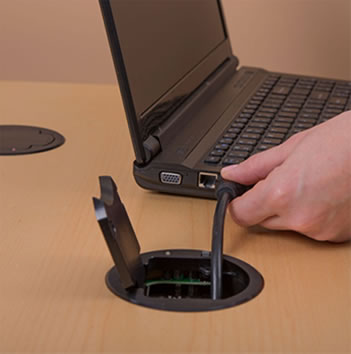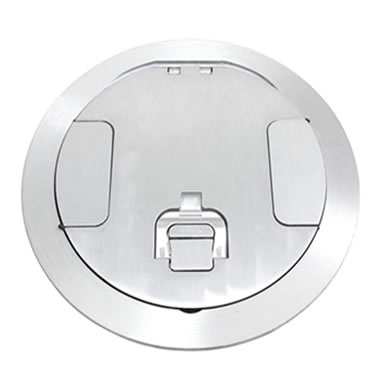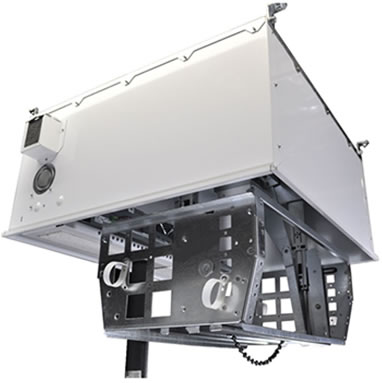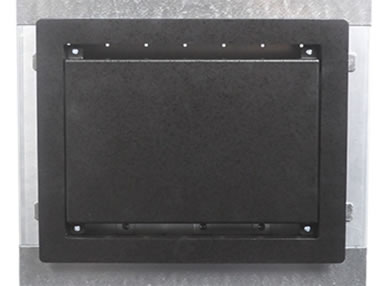When power and audio-visual applications are needed for presentations, plugging devices or cords into one convenient location makes the process more streamlined. A/V power boxes allow for power, voice, data, and video cable connection points in one location in the room.
Depending on the setup of the room and the equipment being used, these power boxes can be located on the ceiling, floor, table, or wall.

FSR HV-600 HuddleVU 6-HDMI
Tabletop Boxes
Found in classrooms and conference centers where presentations are common, tabletop A/V power boxes can sit flush with the furniture or sit below and rise when needed. Although named tabletop boxes, they can also be installed on podiums and other furniture. They come in many finishes to match the surrounding decor as much as possible.
The tabletop A/V box is the best choice for venues where multiple devices or cords will be switched out regularly because of its easily accessible outlets. They are also built to withstand accidents such as spilled coffee, which is common in conference rooms and classrooms.

FSR SF8-CPT-JNC2-ALM 8″ PK with Cover and 2 AC Sub-Plates
Floor Boxes
Floor A/V power boxes are found in rooms with raised floors. Cables run underneath and into the boxes, which provide extra outlets for power or audio-visual applications. They generally sit below the floor, with the door sitting flush with the flooring. The covers for floor boxes can blend seamlessly with carpet.
This type of A/V power box is commonly found in corporate office and educational buildings or an equipment room. In an office setting, they allow each person at a desk to plug into electrical devices, telephone lines, and computer equipment. From college lecture halls to gymnasiums, educational facilities can benefit from floor boxes by providing compatibility with a wide range of A/V equipment without lengthy cables, wires and connections becoming an obstacle. In computer or equipment rooms, they are favored because cables can be easily installed and changed under the raised flooring.

FSR CB-224S 2’x2′ CB w/ 4 1RU Mounts, Smart AC and Fan
Ceiling Boxes
Hiding cords for A/V equipment such as a projector is easy with a ceiling A/V power box. Many of these boxes have racks to hold heavier equipment. These are best suited for cables that run through the ceiling, and not for plugging in other temporary devices or equipment.
Ceiling A/V power boxes are best used in schools, meeting facilities, and conference centers with need for ceiling-mounted projectors and accessories.

FSR PWB-450-BLK Large Format Wall box with 4 AC and 3 1-Gang plates & 1 IPS- (Door Finish-Black)
Wall Boxes
When the wall is the easiest place to access, wall A/V power boxes are the best fit. These boxes are incredibly diverse in their capabilities. Some deal specifically with stereo audio while others are utilized when transmitting computer graphic video signals. Wall boxes sit flush with the wall to blend in with the room.
Using a wall A/V power box is best in situations when other wall mounted equipment such as digital signage, electronic billboards, and airports is in use but they have a wide range of other uses too.
Questions to Ask
When deciding between a tabletop, floor, ceiling, or wall A/V power box, ask these questions:
- Where are the cables located?
Deciding which to use depends on where the cables are coming from (under the floor, through the ceiling), and where electronics need to be plugged in.
- What capabilities does it need?
Not all boxes handle audio, power, and video at the same time. The capabilities needed for the usage is a more important factor than where the box is located. Make sure the box has every type of connection needed for the job.
- Does the box need to blend in?
Floor and tabletop boxes are great at blending in with their surroundings because of their ability to be recessed and availability in many finishes. In environments where this is important, go for those options. When it’s not, ceiling and wall boxes are also viable options.
AV Superstore can help direct customers to find the perfect power boxes for any audio-visual needs. Look through the selection of available tabletop, wall, ceiling and floor boxes on the AV Superstore website.
